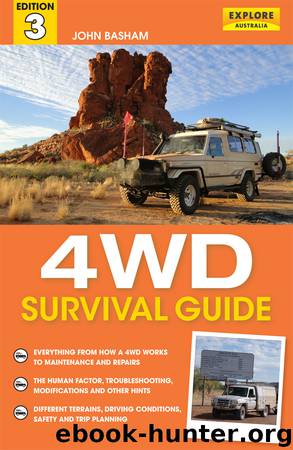4WD Survival Guide by John Basham

Author:John Basham
Language: eng
Format: epub
ISBN: 9781742739007
Publisher: Explore Australia Publishing
Published: 2012-10-21T16:00:00+00:00
Fuel tanks
Working out 4WD fuel usage, I still prefer to use kilometres per litre, and I know from experience my vehicle gets about 450 kilometres to a tankful of fuel in hard-going conditions. On the blacktop (bitumen) in easier driving, from the same tank I can get about 600 kilometres. When the gauge shows around quarter full, that’s about 20 useable litres left, so at 6 kilometres per litre I expect to be able to do around 120 kilometres. Notice the reference to useable litres. An empty and run-dry 90 litre manufactured-capacity tank might only take 75 litres on a maximum refill. In this case the engine cannot access the remaining 15 litres in the tank. You’ll get most total distance from the fuel tank on flat ground; sand dunes and mountain slopes sometimes slosh or drain the fuel away from the fuel inlet or pick-up point inside the tank. Check your vehicle’s tank carefully, and be sure just how much fuel you can really put into the tank, because capacities of individual vehicle tanks vary.
Most fuel pick-ups or inlets are towards the front of the tank. In an uphill situation, remember that with not much fuel left in a tank, the fuel may be positioned to the rear, and air might get into the fuel line. This often causes engine stoppage. In most cases, restarting becomes merely a brief nuisance in a petrol-engined vehicle but it can be time-consuming and annoying for some models of diesel engines. Fortunately, it’s generally only the older side-injection diesels which may need to be bled and primed; many direct-injection diesel engines will self-prime, assuming the tank has sufficient fuel for the engine to use. Re-starting can be one place where a fully charged battery is very handy, because the starter-motor might need to spin for a minute or two to pump fuel through the system, till the engine fires again.
Carrying and storing fuel on any trip can be a nuisance. Many four-wheel drivers carry spare fuel in jerrycans, often up on the roof-rack. Full jerrycans at that height change the vehicle’s centre of gravity and will affect the way it handles. To help reduce body lean or sway the containers can be laid flat, which can be a good way to carry them. However, doing it this way the lid seals might leak unless they are in good condition. If the cans are too full, expansion from the sun’s heat can make them weep or bulge and split. Full fuel cans are heavy and place a lot of strain on the roof-rack and its mounting points.
Never carry them inside a vehicle as fumes can be very dangerous. Specially made carry-racks for jerrycans of fuel on rear bumpers is one effective way to transport them. Do not carry them at the front due to risk of them splitting and causing a fire in the event of a collision. LPG containers should not be carried inside a vehicle either. Regulations vary from state to state on carrying what really is explosive fuel in a vehicle.
Download
This site does not store any files on its server. We only index and link to content provided by other sites. Please contact the content providers to delete copyright contents if any and email us, we'll remove relevant links or contents immediately.
Whiskies Galore by Ian Buxton(41533)
Introduction to Aircraft Design (Cambridge Aerospace Series) by John P. Fielding(32890)
Small Unmanned Fixed-wing Aircraft Design by Andrew J. Keane Andras Sobester James P. Scanlan & András Sóbester & James P. Scanlan(32574)
Aircraft Design of WWII: A Sketchbook by Lockheed Aircraft Corporation(32138)
Craft Beer for the Homebrewer by Michael Agnew(17935)
Turbulence by E. J. Noyes(7702)
The Complete Stick Figure Physics Tutorials by Allen Sarah(7143)
The Institute by Stephen King(6804)
Kaplan MCAT General Chemistry Review by Kaplan(6597)
The Thirst by Nesbo Jo(6439)
Bad Blood by John Carreyrou(6278)
Modelling of Convective Heat and Mass Transfer in Rotating Flows by Igor V. Shevchuk(6225)
Learning SQL by Alan Beaulieu(6037)
Weapons of Math Destruction by Cathy O'Neil(5832)
Man-made Catastrophes and Risk Information Concealment by Dmitry Chernov & Didier Sornette(5650)
Permanent Record by Edward Snowden(5541)
Digital Minimalism by Cal Newport;(5392)
Life 3.0: Being Human in the Age of Artificial Intelligence by Tegmark Max(5189)
iGen by Jean M. Twenge(5163)
